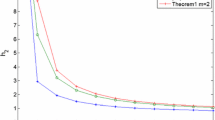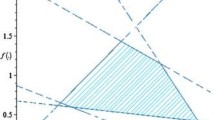Abstract
This paper is concerned with the problem of delay-dependent stability analysis for a class of two-dimensional (2D) discrete switched systems described by the Roesser model with state delays. First, the concept of average dwell time is extended to 2D switched systems with state delays. Then, based on the average dwell time approach, a delay-dependent sufficient condition for the exponential stability of the addressed systems is derived. All the results are formulated in terms of linear matrix inequalities (LMIs), which can be solved efficiently. A numerical example is given to illustrate the effectiveness of the proposed method.




Similar content being viewed by others
References
B. Anderson, P. Agathoklis, E.I. Jury, M. Mansour, Stability and the matrix Lyapunov equation for discrete 2-dimensional systems. IEEE Trans. Circuits Syst. 33(3), 261–267 (1986)
A. Benzaouia, A. Hmamed, F. Tadeo, Stability conditions for discrete 2D switching systems, based on a multiple Lyapunov function, in European Control Conference, Budapest, Hungary, August (2009), pp. 23–26
A. Benzaouia, A. Hmamed, F. Tadeo, A.E. Hajjaji, Stabilisation of discrete 2D time switching systems by state feedback control. Int. J. Syst. Sci. 42(3), 479–487 (2011)
S.P. Boyd, L.E. Ghaoui, E. Feron, V. Balakrishnan, Linear Matrix Inequalities in System and Control Theory (SIAM, Philadelphia, 1994)
M.S. Branicky, Multiple Lyapunov functions and other analysis tools for switched and hybrid systems. IEEE Trans. Autom. Control 43(4), 186–200 (1998)
S.F. Chen, Stability analysis for 2-D systems with interval time-varying delays and saturation nonlinearities. IEEE Trans. Signal Process. 90(7), 2265–2275 (2010)
S.F. Chen, Delay-dependent stability for 2D systems with time-varying delay subject to state saturation in the Roesser model. Appl. Math. Comput. 216(9), 2613–2622 (2012)
C. Du, L. Xie, Control and Filtering of Two-Dimensional Systems (Springer, Berlin, 2002)
Z.Y. Feng, L. Xu, M. Wu, Y. He, Delay-dependent robust stability and stabilisation of uncertain two-dimensional discrete systems with time-varying delays. IET Control Theory Appl. 4(10), 1959–1971 (2010)
E. Fornasini, G. Marchesini, Stability analysis of 2-D systems. IEEE Trans. Circuits Syst. CAS-27(10), 1210–1217 (1980)
Y. He, M. Wu, G.P. Liu, J.H. She, Output feedback stabilization for a discrete-time system with a time-varying delay. IEEE Trans. Autom. Control 53(10), 2372–2377 (2008)
J.P. Hespanha, A.S. Morse, Stability of switched systems with average dwell time, in Proceedings of the 38th IEEE Conference on Decision and Control (1999), pp. 2655–2660
K. Hu, J. Yuan, Improved robust H ∞ filtering for uncertain discrete-time switched systems. IET Control Theory Appl. 3(3), 315–324 (2009)
T. Kaczorek, Two-Dimensional Linear Systems (Springer, Berlin, 1985)
Q.K. Li, J. Zhao, G.M. Dimirovski, Tracking control for switched time-varying delays systems with stabilizable and unstabilizable subsystems. Nonlinear Anal. Hybrid Syst. 3(2), 133–142 (2009)
X. Li, H. Gao, A new model transformation of discrete-time systems with time-varying delay and its application to stability analysis. IEEE Trans. Autom. Control 56(9), 2172–2178 (2011)
X. Li, H. Gao, X. Yu, A unified approach to the stability of generalized static neural networks with linear fractional uncertainties and delays. IEEE Trans. Syst. Man Cybern., Part B, Cybern. 41(5), 1275–1286 (2011)
W.S. Lu, Two-Dimensional Digital Filters (Marcel Dekker, New York, 1992)
W.S. Lu, E. Lee, Stability analysis for two-dimensional systems via a Lyapunov approach. IEEE Trans. Circuits Syst. 32(1), 61–68 (1985)
W. Paszke, J. Lam, K. Galkowski, S. Xu, A. Kummert, Delay-dependent stability condition for uncertain linear 2-D state-delayed systems, in Proc. 45th IEEE Conf. on Decision and Control, San Diego, CA, USA, December (2006), pp. 2783–2788
W. Paszke, J. Lam, K. Galkowski, S. Xu, Z. Lin, Robust stability and stabilisation of 2D discrete state-delayed systems. Syst. Control Lett. 51(3/4), 277–291 (2004)
D. Peng, X. Guan, H ∞ filtering of 2-D discrete state-delayed systems. Multidimens. Syst. Signal Process. 20(3), 265–274 (2009)
J. Qiu, Y. Xia, H. Yang, J. Zhang, Robust stabilisation for a class of discrete-time systems with time-varying delays via delta operators. IET Control Theory Appl. 2(1), 87–93 (2008)
F.O. Souza, R.M. Palhares, New delay-interval stability condition. Int. J. Syst. Sci. (2012). doi:10.1080/00207721.2012.720297
X.M. Sun, J. Zhao, D.J. Hill, Stability and L 2-gain analysis for switched delay systems: a delay-dependent method. Automatica 42(10), 1769–1774 (2006)
Y.G. Sun, L. Wang, G. Xie, Delay-dependent robust stability and stabilization for discrete-time switched systems with mode-dependent time-varying delays. Appl. Math. Comput. 180(2), 428–435 (2006)
Y.G. Sun, L. Wang, G. Xie, Delay-dependent robust stability and H ∞ control for uncertain discrete-time switched systems with mode-dependent time delays. Appl. Math. Comput. 187(2), 1228–1237 (2007)
R. Wang, J. Zhao, Guaranteed cost control for a class of uncertain switched delay systems: an average dwell-time method. Cybern. Syst. 38(1), 105–122 (2007)
Y.J. Wang, Z.X. Yao, Z.Q. Zuo, H.M. Zhao, Delay-dependent robust H ∞ control for a class of switched systems with time delay, in IEEE International Symposium on Intelligent Control (2008), pp. 882–887
Z. Xiang, S. Huang, Stability analysis and stabilization of discrete-time 2D switched systems. Circuits Syst. Signal Process. 32(1), 401–414 (2013)
G. Xie, L. Wang, Stabilization of switched linear systems with time-delay in detection of switching signal. J. Math. Anal. Appl. 305(6), 277–290 (2005)
H. Xu, S. Xu, J. Lam, Positive real control for 2-D discrete delayed systems via output feedback controllers. J. Comput. Appl. Math. 216(1), 87–97 (2008)
H. Xu, Y. Zou, J.W. Lu, S. Xu, Robust H ∞ control for a class of uncertain nonlinear two-dimensional systems with state delays. J. Franklin Inst. 342(7), 877–891 (2005)
J.M. Xu, L. Yu, H ∞ control of 2-D discrete state delay systems. Int. J. Control. Autom. Syst. 4(4), 516–523 (2006)
J.M. Xu, L. Yu, Delay-dependent H ∞ control for 2-D discrete state delay systems in the second FM model. Multidimens. Syst. Signal Process. 20(4), 333–349 (2009)
S. Ye, W. Wang, Stability analysis and stabilisation for a class of 2-D nonlinear discrete systems. Int. J. Syst. Sci. 42(5), 839–851 (2011)
S. Ye, W. Wang, Y. Zou, J. Yao, Delay-dependent stability analysis for two-dimensional discrete systems with shift delays by the general models, in Proceedings of 10th International Conf. Control, Automation, Robotics and Vision (2008), pp. 973–978
H.B. Zeng, Y. He, M. Wu, C.F. Zhang, Complete delay-decomposing approach to asymptotic stability for neural networks with time-varying delays. IEEE Trans. Neural Netw. 22(5), 806–812 (2011)
G. Zhai, B. Hu, K. Yasuda, A.N. Michel, Stability analysis of switched systems with stable and unstable subsystems: an average dwell time approach, in Proceedings of the American Control Conference, (2000), pp. 200–204
Acknowledgements
This work was supported by the National Natural Science Foundation of China under Grant No. 61273120.
Author information
Authors and Affiliations
Corresponding author
Appendix: The proof of Theorem 1
Appendix: The proof of Theorem 1
Proof
Without loss of generality, we assume that the kth subsystem is active. We consider the following Lyapunov–Krasovskii functional candidate for the kth subsystem:
where
where

are real matrices to be determined.
Then we have










By Lemma 2, it can be obtained from (19) and (24) that


Denote
From (25) and (26), we obtain the following relationship:

where

In addition, applying Lemma 1, inequality (8) is equivalent to the following inequality:
Thus, it is easy to obtain
Notice that for any nonnegative integer D>z=max(z 1,z 2), one has that V h(0,D)=V v(D,0)=0. Then summing up both sides of (28) from D−1 to 0 with respect to j and 0 to D−1 with respect to i, one gets

Assume that the switching number of σ(i,j) on an interval [z,D) is υ=N σ(i,j)(z,D), and let (i κ−υ+1,j κ−υ+1),(i κ−υ+2,j κ−υ+2),…,(i κ ,j κ ) denote the switching points of σ(i,j) over the interval [z,D). Thus, denoting m i =i i +j i , i=κ−υ+1,…,κ, it follows from (10) and (29) that

Notice from (14) that there exist two positive constants a and b(a<b) such that

Combining (30) and (31), we obtain
By Definition 1, it follows from (9) that 2D discrete switched system (1) is exponentially stable. The proof is completed. □
Rights and permissions
About this article
Cite this article
Huang, S., Xiang, Z. Delay-Dependent Stability for Discrete 2D Switched Systems with State Delays in the Roesser Model. Circuits Syst Signal Process 32, 2821–2837 (2013). https://doi.org/10.1007/s00034-013-9600-9
Received:
Revised:
Published:
Issue Date:
DOI: https://doi.org/10.1007/s00034-013-9600-9




